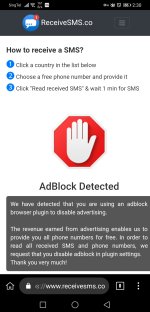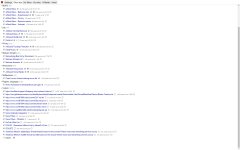People who optimize for shorter lists are over-optimizing for it.
This is not true, let me explain my point (start of rant

, not against Handsome recluse, but against "more is less, benefits of large block-list perception" in general)
There are nearly three billion websites, but in the Western world 2 (two!) companies serve half of the ads (Google and Facebook). The top 100 advertising networks have a market share of around 80%, the top 200 around 90%. Lists with 3000 to 4000 rules (Peter Low's, Disconnect, Ghostery) block 95% of the advertisements. With 40.000 rules (Adguard optimzed) you might block 97% and with 1.5 million 98%.
It is not about blocking individual ads on websites, but blocking third-party access of advertising networks on these websites. Visitors are tracked on websites. Those visitors are served (interest based) ads not by the website they are visiting, but by the advertising network which pushes ads to the website you are visiting. It costs money to build an ad-serving infrastructure. For displaying an advertisement (and more important a click through) websites get paid in cents, so you need a lot of traffic to earn money from it.
These two factors, the money involved to build an advertising network and the low payment per advertising display, is the reason that there are a limited number of advertising networks. In every market in the capitalistic world the market share is divided by a limited number of players. As a rule of thumb the higher the price of infrastructure or production of a product (e.g. 5G network providers or car manufacturers), the lower the number of market players. Same applies on market maturity, the older the market the lower the number of players involved (e.g. vendors of branded diary products).
It is the same with payment services (see post:
Q&A - List of digital payment services per country ) In the Netherlands less than 10 players serve maybe 20 million websites. Simply because it takes money to build such an infrastructure. When you want to prevent your family members from buying online, you don't need a block list of 20.000.0000 rules, just block the 10 digital payment services servicing the Dutch websites. For the Netherlands a block-list of 40 third-party block rules (listing banks and payment services operating in the Netherlands) will probably be sufficient to prevent all your family members buying on-line on 95% of the 20 million Dutch websites. Hunting the last 5% down, would cost a lot more effort. It is the same with advertisements, the effort to catch the last 10 to 5 percent of the long tail is tremendous.
Normal market mechanism apply to the digital market as well. In most markets 20% of the players account for 80% of the turnover. The remaining 20% is divided between a lot of smaller players. Because of the low prevalence of those small players, those smaller ad-networks are not blocked by ad-blockers and serve a specific niche or language market. Only when you visit a lot of niche websites, large block list might be beneficial. But the odds such a niche player is included in a large block-list are still low (a block-list of 300.0000 website specific rules only covers 0,001 percent of the websites in the world). The reverse is true: people with large block-list over-optimize: they arm themselves against websites they never visit and not-curated dead ad-links (curation is a major problem of community based block-list).
My take on less is more versus more is less:
- W3Tech top 200 list is an example of a bare minimum (the bottom range and minimalist take of/on less is more)
- Peter Low's, Ghostery and Disconnect (with < 4000 rules) block without breaking (reason both Firefox and Edge-Chromium use Disconnect), These list are the representatives of the main stream (less is more) approach.
- Adguard's optimized filters (less than 40.000 rules) is the optimum where less is more and more is less meet. Adguard gets feedback about the (originally Easylist rules) which are really used, making Adguard's optimized filters currently the best in the market (highes blockrate with lowest functional breakage). The automated feedback mechanism skips/omits websites with low traffic and dead ad-links. A simular optimum can be achieved with uBlockOrigin using uBO's own filter plus Steven Black's hostlist (but you have to know how to add that) and everything else disabled.
- uBlock's with its own uB0-filters and only Peter Low's and Easylist ads plus trackers is probably the optimum for a more is less approach.
- uBlock's default without the malware protection is probably the maximum useful of more is less approach. Adding more is futile.
Hope people understand why less is more is 95% effective as more is less and chasing the last 5% is futile (end of rant

)
P.S. with a block-list of under 250 rules, I never run into anti-ad-block walls, another advantage of a small block-list!








